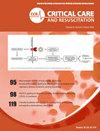Comparison of baseline characteristics, treatment and celinical outcomes of critically ill COVID-19 patients admitted in the first and second waves in Australia.
IF 1.4
4区 医学
Q3 CRITICAL CARE MEDICINE
Critical Care and Resuscitation
Pub Date : 2023-10-18
eCollection Date: 2021-09-06
DOI:10.51893/2021.3.OA8
引用次数: 10
Abstract
Objective: To report longitudinal differences in baseline characteristics, treatment, and outcomes in patients with coronavirus disease 2019 (COVID-19) admitted to intensive care units (ICUs) between the first and second waves of COVID-19 in Australia. Design, setting and participants: SPRINT-SARI Australia is a multicentre, inception cohort study enrolling adult patients with COVID-19 admitted to participating ICUs. The first wave of COVID-19 was from 27 February to 30 June 2020, and the second wave was from 1 July to 22 October 2020. Results: A total of 461 patients were recruited in 53 ICUs across Australia; a higher number were admitted to the ICU during the second wave compared with the first: 255 (55.3%) versus 206 (44.7%). Patients admitted to the ICU in the second wave were younger (58.0 v 64.0 years; P = 0.001) and less commonly male (68.9% v 60.0%; P = 0.045), although Acute Physiology and Chronic Health Evaluation (APACHE) II scores were similar (14 v 14; P = 0.998). High flow oxygen use (75.2% v 43.4%; P < 0.001) and non-invasive ventilation (16.5% v 7.1%; P = 0.002) were more common in the second wave, as was steroid use (95.0% v 30.3%; P < 0.001). ICU length of stay was shorter (6.0 v 8.4 days; P = 0.003). In-hospital mortality was similar (12.2% v 14.6%; P = 0.452), but observed mortality decreased over time and patients were more likely to be discharged alive earlier in their ICU admission (hazard ratio, 1.43; 95% CI, 1.13–1.79; P = 0.002). Conclusion: During the second wave of COVID-19 in Australia, ICU length of stay and observed mortality decreased over time. Multiple factors were associated with this, including changes in clinical management, the adoption of new evidence-based treatments, and changes in patient demographic characteristics but not illness severity.澳大利亚第一波和第二波新冠肺炎危重患者基线特征、治疗和临床结果比较
目的:报告澳大利亚第一波和第二波COVID-19入住重症监护病房(icu)的2019冠状病毒病(COVID-19)患者的基线特征、治疗和结局的纵向差异。设计、环境和参与者:SPRINT-SARI澳大利亚是一项多中心、初始队列研究,纳入了进入icu的成年COVID-19患者。第一波COVID-19疫情发生在2020年2月27日至6月30日,第二波疫情发生在2020年7月1日至10月22日。结果:澳大利亚53个icu共招募了461名患者;第二波入住ICU的人数高于第一波:255人(55.3%)对206人(44.7%)。第二波入住ICU的患者较年轻(58.0 v 64.0岁;P = 0.001),男性较少(68.9% vs 60.0%;P = 0.045),尽管急性生理和慢性健康评估(APACHE) II评分相似(14 v 14;P = 0.998)。高流量耗氧量(75.2% v 43.4%;P < 0.001)和无创通气(16.5% v 7.1%;P = 0.002)在第二波中更为常见,类固醇使用也更为常见(95.0% vs 30.3%;P < 0.001)。ICU住院时间较短(6.0 v 8.4 d);P = 0.003)。住院死亡率相似(12.2% vs 14.6%;P = 0.452),但观察到的死亡率随着时间的推移而下降,患者更有可能在ICU入院时更早活着出院(风险比,1.43;95% ci, 1.13-1.79;P = 0.002)。结论:在澳大利亚第二波COVID-19期间,ICU住院时间和观察死亡率随时间而下降。多种因素与此相关,包括临床管理的变化,采用新的循证治疗方法,以及患者人口统计学特征的变化,但不包括疾病严重程度的变化。
本文章由计算机程序翻译,如有差异,请以英文原文为准。
求助全文
约1分钟内获得全文
求助全文
来源期刊

Critical Care and Resuscitation
CRITICAL CARE MEDICINE-
CiteScore
7.70
自引率
3.40%
发文量
44
审稿时长
>12 weeks
期刊介绍:
ritical Care and Resuscitation (CC&R) is the official scientific journal of the College of Intensive Care Medicine (CICM). The Journal is a quarterly publication (ISSN 1441-2772) with original articles of scientific and clinical interest in the specialities of Critical Care, Intensive Care, Anaesthesia, Emergency Medicine and related disciplines.
The Journal is received by all Fellows and trainees, along with an increasing number of subscribers from around the world.
The CC&R Journal currently has an impact factor of 3.3, placing it in 8th position in world critical care journals and in first position in the world outside the USA and Europe.
文献相关原料
| 公司名称 | 产品信息 | 采购帮参考价格 |
|---|
 求助内容:
求助内容: 应助结果提醒方式:
应助结果提醒方式:


